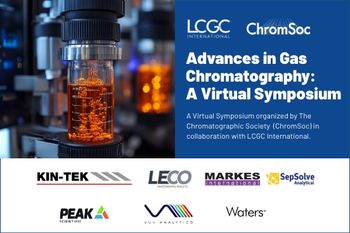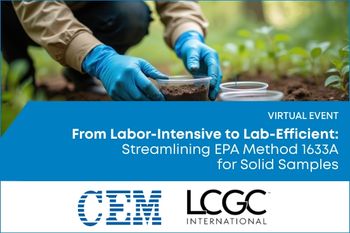
- LCGC Europe-05-01-2017
- Volume 30
- Issue 5
UHPLC Coupled with Accurate Mass and High Resolution Mass Spectrometry for Complex Environmental Analyses
Environmental analyses of food, soil, and water have changed dramatically over the last decade. Topics such as pesticides, food additives, and natural products have become important as food products are globally grown and distributed (1). Monitoring their quality is critical to international business. Pharmaceuticals, fluorinated surfactants, and endocrine disruptors in water are major new topics, where not only parent compounds are unknown but also their metabolites and degradation products are often more important or more abundant than the parent compound (2). New environmental issues, such as hydraulic fracturing and its wastewater, have captured our attention as the production of oil and gas has increased exponentially in the past decade (3). With this technology comes the problem of wastewater disposal and groundwater contamination. These environmental issues have greatly benefited from the combination of ultrahigh‑performance liquid chromatography (UHPLC) mated to high resolution mass spectrometry (HRMS
Environmental analyses of food, soil, and water have changed dramatically over the last decade. Topics such as pesticides, food additives, and natural products have become important as food products are globally grown and distributed (1). Monitoring their quality is critical to international business. Pharmaceuticals, fluorinated surfactants, and endocrine disruptors in water are major new topics, where not only parent compounds are unknown but also their metabolites and degradation products are often more important or more abundant than the parent compound (2). New environmental issues, such as hydraulic fracturing and its wastewater, have captured our attention as the production of oil and gas has increased exponentially in the past decade (3). With this technology comes the problem of wastewater disposal and groundwater contamination. These environmental issues have greatly benefited from the combination of ultrahighâperformance liquid chromatography (UHPLC) mated to high resolution mass spectrometry (HRMS). Because suppression by matrices creates challenges in environmental analysis, both sample preparation, such as solid-phase extraction (SPE), and UHPLC make important contributions to eliminating or reducing suppression.
The analysis of environmental samples has challenged our ability to separate the thousands of compounds that are present in a food or water extract. Furthermore, the salts and metal ions associated with these extracts further complicate the analytical challenges. HRMS, such as time-of-flight MS and Orbitrap MS, has been adopted by many laboratories to address these pressing environmental issues. To gain the most from HRMS, UHPLC has been rapidly accepted as a separation method. In particular, the use of sub-2-µm particles in a variety of packing materials has enabled the mass spectroscopist to fully appreciate the power of HRMS and accurate mass by separating compounds of isobaric mass, as well as isotopes of various compounds that have the same identical mass. Even the highest resolving power in mass spectrometry will not separate two isomers that have the same formula; thus, UHPLC plays a critical role in separation and identification of environmental targets. A separation by UHPLC then allows the use of
MS/MS followed by accurate mass for identification.
For example, pharmaceuticals in water may have not only identical formulas (isomers) but may also have nearly identical MS/MS spectra. The analysis problem of tramadol and desvenlafaxine are just that problem (4). The use of UHPLC using a C-8 column was easily able to separate these two isomers, such that they could be identified correctly (4). The importance of these pharmaceuticals is that they may contribute to the formation of dimethylnitrosoamine (NDMA), which is an important new chlorination product created in water treatment (5).
A valuable mass spectrometry technique, auto
MS/MS, is available from many vendors of highâresolution mass spectrometers. The peak capacity of the analytical column used in UHPLC is valuable for this type of analysis because it gives the auto MS/MS spectra a more easily interpreted accounting of the unknowns present in a food or water extract. The MS/MS spectra may then be correlated to various libraries currently available without the interference of matrix materials.
Another reason to increase the resolution in chromatography before mass spectrometry is the current availability of complex databases. With accurate mass analysis, it is possible to create a database of accurate masses for any compounds that one would like to investigate in an environmental sample, that is, of course, if that compound will ionize in either positive or negative ion electrospray. However, the limitation of the database lies in the fact that sometimes as many as a thousand isomers may exist for a formula, such as a simple fungicide of the elements, C, H, N, and O. How does one tackle this problem? One powerful technique is slow chromatography with high peak capacity and reproducibility of retention time. This allows one to use retention time in the mass spectrometry database to accurately pull out targeted compounds and radically decrease the false positives caused by isomeric compounds.
Another important advance in mass spectrometry is the use of ion mobility for the separation of surfactants associated with wastewater from hydraulic fracturing.
The complexity of surfactants adds to the hundreds of ions associated with a single group of compounds. These surfactants are used as clay stabilizers and emulsifiers to move oil and gas from deep underground to the surface. The combination of a heatmap generated by UHPLC versus IM drift time is a powerful visual tool to see and identify new groups of compounds present in wastewater samples. This is especially important in that these surfactants may contribute to earthquake occurrence when these wastewaters are disposed of by deep well injection, a common technique in the United States (6).
Thus, HRMS does not stand alone in the conundrum of environmental analysis. The power of separation methods, including UHPLC and advances in sample preparation (solid-phase extraction and other sample preparation tools), brings us ever closer to fully characterizing the environmental pollutants in food, soil, and water. HPLC 2017 will highlight and encourage us in the field of environmental analysis to continue this interesting journey in high resolution chromatography.
References
- E.M. Thurman et al., Anal. Chem.78, 6703–6708 (2006).
- M. Strynar et al., Environ. Sci. Technol.49, 11622–11630 (2015).
- Y. Lester et al., STOTEN512, 637–644 (2015).
- I. Ferrer and E.M. Thurman, J. Chromatogr. A1259, 158–166 (2012).
- D. Hanigan et al., Environ. Sci. Technol. Lettrs.2, 151–157 (2015).
- W.L. Ellsworth, Science 341, 142 (2013).
E. Michael Thurman and Imma Ferrer, Laboratory of Environmental Mass Spectrometry, University of Colorado, Boulder, Colorado, USA.
Articles in this issue
over 8 years ago
(U)HPLC: The Shape of Things To Comeover 8 years ago
The Role of LC–MS in Lipidomicsover 8 years ago
Contemporary Trends in Biopharmaceutical Analysisover 8 years ago
Advances in Glycomics in Biology and Medicineover 8 years ago
The Rising Profile of Comprehensive 2D LCover 8 years ago
New Gas Chromatography Products for 2016–2017Newsletter
Join the global community of analytical scientists who trust LCGC for insights on the latest techniques, trends, and expert solutions in chromatography.





